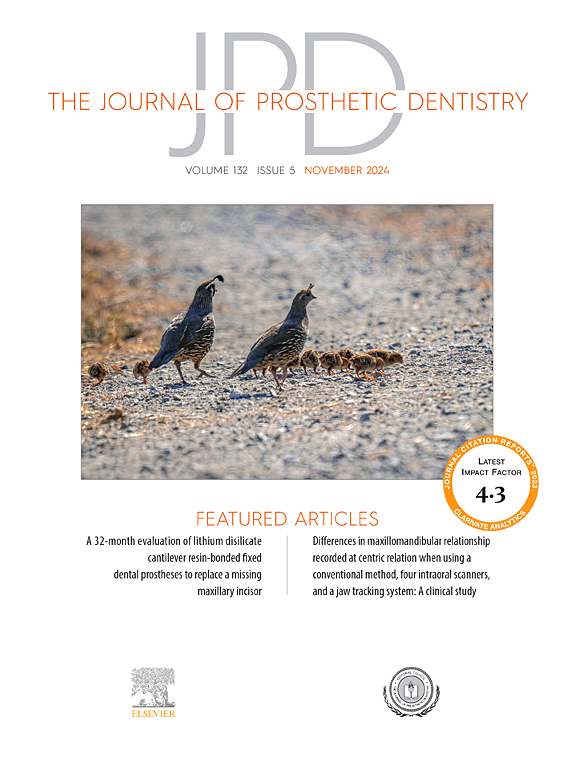Evaluation of the biomechanics of Aramany class I obturators of different designs using numerical and experimental methods. Part II: Stress distribution
IF 4.3
2区 医学
Q1 DENTISTRY, ORAL SURGERY & MEDICINE
引用次数: 0
Abstract
Statement of problem
Evidence regarding stress evaluations of removable obturators with Aramany class I defects is lacking. Whether the stress distribution on Aramany class I prostheses can be improved by modifying the currently used designs is also unclear.
Purpose
The purpose of part II of this study was to evaluate the stress distribution in different designs of Aramany class I obturators using finite element analysis (FEA) and photoelastic stress analysis.
Material and methods
Four finite element and 8 photoelastic models, including 2 acrylic resin base obturators retained with 2 Adams clasps, 2 linear, 2 tripodal, and 2 fully tripodal design obturators, were used in this study. The frameworks were fabricated on the casts obtained from a modified printed model. Vertical and oblique loads were applied on 2 points (anterior and posterior) of the models. The quantitative measurement was done by measuring the fringe orders and von Mises values to compare the influences of occlusal forces on the obturator components and their supporting structures. The qualitative evaluation was done by visual color mapping to identify the stress concentration.
Results
In the photoelastic analysis, the anterior abutments of the tripodal showed the highest stress, followed by the fully tripodal obturators, while, in FEA, the anterior abutments of the linear design received the most in both vertical and oblique load. The central incisor received the most stress in photoelastic (3 or more fringe orders) and FEA (687.3 and 150.1 MPa for vertical and oblique loads, respectively), followed by the lateral incisors. Upon posterior loading, the base of the defect of the linear design demonstrated the most stress in photoelastic (3 or more fringes) and FEA (94.3 and 130.5 MPa for vertical and oblique loads, respectively). The acrylic resin base obturator retained with Adams clasps demonstrated the lowest stress distribution in abutments and their supporting bone upon anterior and posterior loads.
Conclusions
Upon vertical and oblique load application, the fully tripodal design was comparable with the tripodal in terms of stress distribution. Both designs were better than the linear in response to the same loading. The stress was concentrated at the anterior palatal part of the obturator, the base of the defect, and the junction of the metal and acrylic resin part of the prostheses upon anterior and posterior loading, respectively.
使用数值和实验方法评估不同设计的 Aramany I 类闭锁器的生物力学。第二部分:应力分布。
问题陈述:目前尚缺乏对具有Aramany I类缺陷的可摘义齿进行应力评估的证据。目的:本研究第二部分的目的是使用有限元分析(FEA)和光弹性应力分析来评估不同设计的 Aramany I 类闭锁器的应力分布:本研究使用了 4 个有限元模型和 8 个光弹性模型,包括 2 个丙烯酸树脂基底闭锁器,2 个亚当斯扣,2 个线性闭锁器,2 个三脚架设计闭锁器和 2 个完全三脚架设计闭锁器。骨架是在改良打印模型的铸模上制作的。对模型的两个点(前部和后部)施加垂直和倾斜负荷。定量测量是通过测量边缘阶数和 von Mises 值来比较咬合力对闭锁器部件及其支撑结构的影响。定性评估则是通过视觉颜色图来识别应力集中:在光弹性分析中,三足式前基台的应力最大,其次是全三足式闭锁器,而在有限元分析中,线性设计的前基台受到的垂直和倾斜负荷最大。在光弹性(3 个或更多边缘阶)和有限元分析中,中切牙受到的应力最大(垂直和倾斜负荷分别为 687.3 和 150.1 兆帕),其次是侧切牙。在后方加载时,线性设计的缺损基底在光弹性(3 个或更多条纹)和有限元分析(垂直和倾斜加载时分别为 94.3 和 130.5 兆帕)中显示出最大的应力。用亚当斯卡环固位的丙烯酸树脂基台在承受前后负荷时,基台及其支持骨的应力分布最小:在承受垂直和斜向负荷时,全三叉设计与三叉设计的应力分布相当。在相同负荷下,两种设计都优于线性设计。在前方和后方加载时,应力分别集中在闭锁器的前腭部分、缺损基底以及修复体的金属部分和丙烯酸树脂部分的交界处。
本文章由计算机程序翻译,如有差异,请以英文原文为准。
求助全文
约1分钟内获得全文
求助全文
来源期刊

Journal of Prosthetic Dentistry
医学-牙科与口腔外科
CiteScore
7.00
自引率
13.00%
发文量
599
审稿时长
69 days
期刊介绍:
The Journal of Prosthetic Dentistry is the leading professional journal devoted exclusively to prosthetic and restorative dentistry. The Journal is the official publication for 24 leading U.S. international prosthodontic organizations. The monthly publication features timely, original peer-reviewed articles on the newest techniques, dental materials, and research findings. The Journal serves prosthodontists and dentists in advanced practice, and features color photos that illustrate many step-by-step procedures. The Journal of Prosthetic Dentistry is included in Index Medicus and CINAHL.
 求助内容:
求助内容: 应助结果提醒方式:
应助结果提醒方式:


